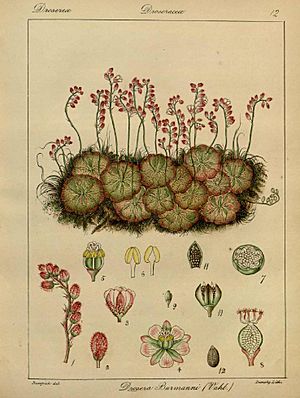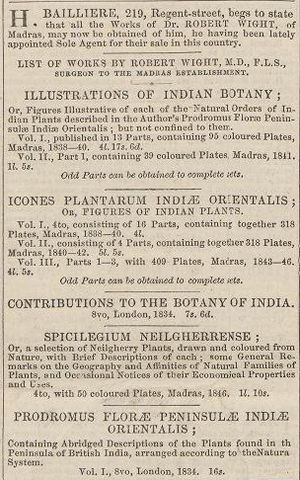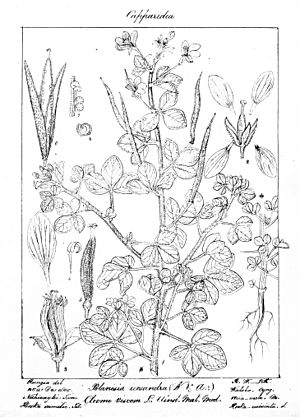Robert Wight facts for kids
Quick facts for kids
Robert Wight
|
|
|---|---|
| Born |
Robert Wight
6 July 1796 |
| Died | 26 May 1872 (aged 75) |
Robert Wight was a Scottish surgeon and a very important botanist. He spent his whole career in southern India, where he made huge discoveries about plants. He helped bring American cotton to India and found 110 new groups (genera) and 1267 new types (species) of flowering plants.
Wight worked with Indian artists to draw the plants he collected. Many of these drawings were published in books. Between 1838 and 1853, he published several illustrated books in India, including the six-volume Icones Plantarum Indiae Orientalis. By the time he left India in 1853, he had published 2464 drawings of Indian plants.
Contents
Robert Wight's Life and Work
His Early Life
Robert Wight was born on July 6, 1796, in Scotland. He was one of twelve children. He studied at home until he was eleven, then went to the Royal High School in Edinburgh. He became a surgeon in 1816 and studied botany (the study of plants) at Edinburgh University.
Starting Work in India
In 1819, Wight moved to India to work as an Assistant Surgeon for the East India Company. He loved plants from the very beginning. He started collecting plants around places like Samalkota and Rajahmundry in India.
In 1826, he became the Madras Naturalist, a special job focused on studying nature. However, this job was ended in 1828, and Wight went back to being a surgeon. From 1828, he started writing to William Hooker, a famous botany professor in Scotland. Wight sent him plant samples and drawings made by his Indian artist, Rungiah.
A Trip Back Home
In 1831, Wight took a three-year break and went back to Britain. He brought with him a huge collection of 100,000 plant samples, weighing about 2 tons! He worked with his friend, George Arnott Walker-Arnott, who was also a botanist. Together, they sorted through the plants and shared copies with other scientists around the world.
Before Wight returned to India in 1834, they published parts of a big book called Prodromus Florae Peninsulae Indiae Orientalis. This book described many plants found in India.
Back in India
Wight returned to India in 1834. He continued to study plants, especially those used for medicine. He also hired local Indian artists to draw the plants. He published his findings in the Madras Journal of Literature and Science.
Studying Plants for Business
Because of his great skills in botany, Wight was moved to the Madras Revenue Department in 1836. His new job was to study agriculture and cotton. For the next six years, he worked on plants like tea, sugar cane, and especially cotton.
In 1842, he became the Superintendent of American Cotton Plantations in Coimbatore. This was a huge project by the government to encourage Indian farmers to grow a new type of American cotton. The idea was to process this cotton using new machines and export it to England. Wight showed that these new cottons could grow in India, even though it was sometimes hard without enough water. The project faced some challenges, but Wight's work was very important for understanding cotton farming in India.
Wight was also an early member of the Madras Agri-Horticultural Society. He helped manage the society's garden, which was like a botanical garden for the city.
Publishing Plant Drawings
Wight's most lasting achievement was his series of illustrated books about Indian plants. He learned from earlier botanists and decided to use a cheaper printing method called lithography. He hired talented Indian artists like Rungiah and later Govindoo. Wight was special because he always gave credit to his artists, printing their names on his books. He even named a plant group, Govindooia, after Govindoo!
His illustrated books included:
- Icones Plantarum Indiae Orientalis (1838–53), which had six volumes of uncolored drawings.
- Illustrations of Indian Botany (1838–50), with two volumes of hand-colored drawings.
- Spicilegium Neilgherrense (1845–51), also with two volumes of hand-colored drawings.
Retirement and Collections
Wight retired from his work in India in March 1853 and returned to England. He bought a large property and planned to continue his plant research. However, he ended up spending more time on farming.
He shared his huge collection of duplicate plant samples with the Kew herbarium (a famous plant collection in England). This collection included over 3100 types of higher plants and 94 types of ferns. He distributed copies to many other plant collections around the world. In 1871, shortly before he passed away, Wight gave his best plant samples, including the original "type" specimens for new species he described, to Kew.
Personal Life
Wight married Rosa Harriet Ford in Madras in 1838. They had four sons and one daughter who lived to be adults. Robert Wight passed away on May 26, 1872, at his home in England.
How He Is Remembered

Wight received many honors for his work. He became a member of the Linnaean Society in 1832 and the Royal Society of London in 1855. He also corresponded with many of the top botanists of his time.
Wight is one of the most remembered Indian botanists. In 1830, another botanist named Wallich named a plant group Wightia after him. Also, 256 different plant species have been named in his honor. This includes flowering plants, ferns, mosses, and algae.
Some plants named after Wight include:
- Aerva wightii
- Anaphalis wightiana
- Andrographis wightiana
- Arenga wightii
- Arisaema wightii
- Beilschmiedia wightii
- Blumea wightiana
- Calophyllum wightianum
- Celtis wightii
- Ceropegia wightii
- Cinnamomum wightii





